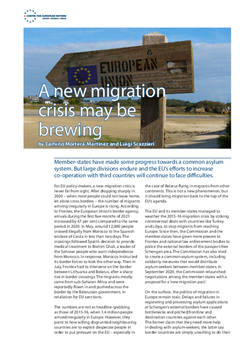
A new migration crisis may be brewing
Member-states have made some progress towards a common asylum system. But large divisions endure and the EU's efforts to increase co-operation with third countries will continue to face difficulties.
For EU policy-makers, a new migration crisis is never far from sight. After dropping sharply in 2020 – when most people could not leave home, let alone cross borders – the number of migrants arriving irregularly in Europe is rising. According to Frontex, the European Union’s border agency, arrivals during the first five months of 2021 increased by 47 per cent compared to the same period in 2020. In May, around 12,000 people crossed illegally from Morocco to the Spanish enclave of Ceuta in less than two days. The crossings followed Spain’s decision to provide medical treatment to Brahim Ghali, a leader of the Sahrawi people who want independence from Morocco. In response, Morocco instructed its border forces to look the other way. Then in July, Frontex had to intervene on the border between Lithuania and Belarus, after a sharp rise in border crossings. The migrants mostly came from sub-Saharan Africa and were reportedly flown in and pushed across the border by the Belarusian government, in retaliation for EU sanctions.
The numbers are not as headline-grabbing as those of 2015-16, when 1.4 million people arrived irregularly in Europe. However, they point to how willing disgruntled neighbouring countries are to exploit desperate people in order to put pressure on the EU – especially in the case of Belarus flying in migrants from other continents. This is not a new phenomenon, but it should bring migration back to the top of the EU’s agenda.
The EU and its member-states managed to weather the 2015-16 migration crisis by striking controversial deals with countries like Turkey and Libya, to stop migrants from reaching Europe. Since then, the Commission and the member-states have given more powers to Frontex and national law enforcement bodies to police the external borders of the passport-free Schengen area. The Commission has also tried to create a common asylum system, including solidarity measures that would distribute asylum-seekers between member-states. In September 2020, the Commission relaunched negotiations among the member-states with a proposal for a ‘new migration pact’.
On the surface, the politics of migration in Europe remain toxic.
On the surface, the politics of migration in Europe remain toxic. Delays and failures in registering and processing asylum applications at Schengen’s external borders have caused bottlenecks and pitched frontline and destination countries against each other. The former claim that they need more help in dealing with asylum-seekers; the latter say border countries are simply unwilling to do their job, as it is easier for them to turn a blind eye to migrants moving into other member-states.
Behind the scenes, however, there has been some progress. In June the member-states agreed to turn the EU’s Asylum Support Office into a fully-fledged EU agency, with more staff and powers to intervene in a crisis. For years, frontline countries insisted that all reforms had to be adopted as a package – they would not take on greater responsibilities for quickly processing arrivals or accept compulsory deployments of EU staff on their territory until there was an agreement to distribute asylum-seekers across the bloc. To break the stalemate, EU countries agreed that the agency should not carry out compliance checks and monitoring, or unilaterally deploy staff on their territory, until other asylum reforms had also been agreed.
The deal on the asylum agency is a small step in the right direction. But other proposed reforms will be harder to conclude. It is unclear whether the processing of asylum applications can be as quick as the Commission would like. And although border states insist on the distribution of asylum-seekers across the EU, this remains controversial. Some member-states continue to think that solidarity measures encourage migrants to come to the EU, while others remain unwilling to take in any migrants at all. EU countries also disagree on when a crisis would be serious enough to trigger solidarity measures.
It may be possible for member-states to make further progress by reaching piecemeal agreements on some of the issues relating to improving access to migrants’ data, and the screening and processing of asylum applications. But the most contentious measures will have to be decided as a package deal, reflecting a compromise between member-states on increased responsibilities for managing arrivals and burden-sharing – whether it is through accepting asylum seekers, contributing with material support or helping with deportations.
Until then, solidarity will continue to take the form of ad-hoc measures by coalitions of willing member-states, and the EU will still focus its efforts on the external dimension of its migration policy, particularly on the common objective of reducing the number of migrants arriving in Europe. The question is whether the EU’s efforts in this direction will be sufficient to deal with new trends in migration – such as climate change creating refugees or unfriendly governments exploiting migrants to put pressure on the Union.
The EU has pushed ahead with plans to deepen co-operation with third countries, saying it intends to use carrots and sticks, including curtailing Schengen visas for countries that are not co-operating. The Union has continued to give money to partners in the Western Balkans, North Africa and the Middle East, to promote economic development and to strengthen their border controls. EU leaders have also agreed to provide new funds to Turkey to help it sustain the millions of refugees that it hosts on its territory. The Union wants to bolster co-operation with Tunisia and with Libya, now that there is a provisional unity government in Tripoli. Perhaps most crucially, the bloc is actively trying to get migrants’ countries of origin to take back nationals whose asylum applications have been rejected. Currently only around a third of those ordered to leave the EU do so, largely because of a lack of co-operation from foreign authorities.
Reliance on partners to keep out migrants will encourage many of them to extract an increasingly high price for co-operation.
All the EU’s efforts to secure greater co-operation from third countries are likely to remain legally difficult and fraught with practical challenges. Its reliance on partners to keep out migrants will encourage many of them to extract an increasingly high price for co-operation, by asking for more money. Meanwhile, the EU’s plans to motivate countries of origin and transit to take back irregular migrants will be difficult to implement. Many countries are deemed unsafe for migrant returns. And for many governments, agreeing to take back their nationals is politically damaging and can mean losing remittances that are worth much more than EU funding.
Despite these challenges, the EU has no choice but to manage migration together with third countries, including with difficult partners – unless member-states are willing to engage in massive pushbacks of migrants or to accept large numbers of irregular arrivals, risking Schengen’s collapse. This means the EU will have to offer its partners more financial help as well as practical assistance and greater avenues for legal migration, in return for their co-operation. But co-operation won’t always be possible and EU leaders should be ready to stand up to coercion by countries that will not hesitate to exploit desperate migrants, like Belarus. If they don’t, they may soon find a new migration crisis brewing.
Camino Mortera-Martinez is a senior research fellow and Luigi Scazzieri is a research fellow at the Centre for European Reform.

